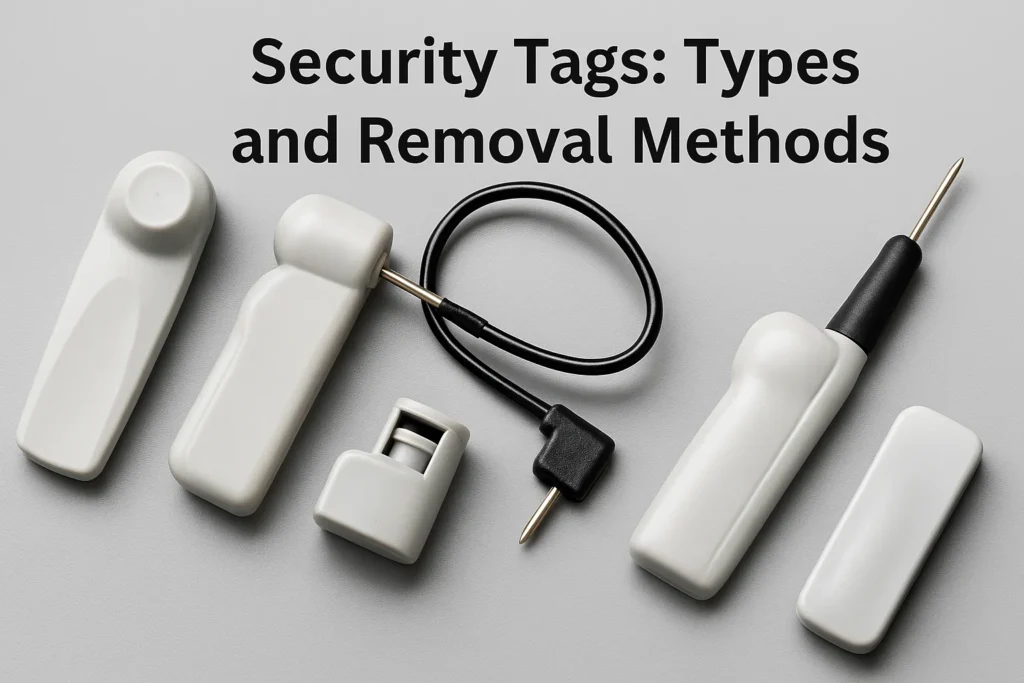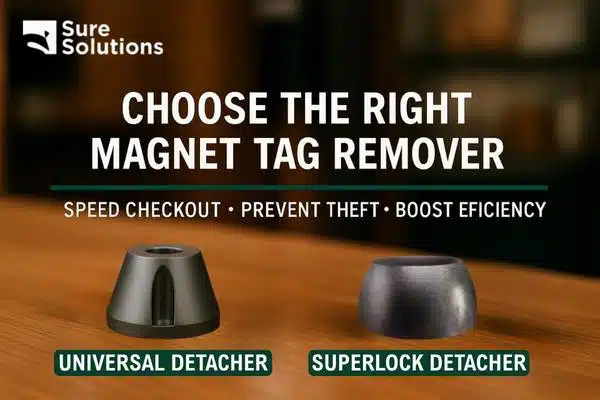Security tags are considered to be a deterrent against theft in stores by protecting the product and businesses in general. There are various types, each with its own method and manner of removal to prevent damage to the merchandise. Employees of the store or authorized personnel must grasp how to identify these tags and properly take them off.
Types of EAS Tags: A Comprehensive Overview
EAS tags come in various forms, each tailored to different types of merchandise and security needs. The most common types include acousto-magnetic (AM) tags, radio frequency (RF) tags, electromagnetic (EM) tags, and microwave tags. Each type has its own unique characteristics and advantages, making them suitable for different retail environments.
- Acousto-magnetic (AM) tags operate at a frequency of around 58 kHz and are known for their large detection range and high resistance to shielding. These tags are ideal for protecting high-value items and are commonly used in clothing stores, electronics retailers, and department stores. The tags are deactivated using an AM deactivator at the point of sale, ensuring a smooth customer experience.
- Radio frequency (RF) tags function at frequencies between 1.75 and 9.5 MHz. These tags are widely used due to their cost-effectiveness and versatility. RF tags can be applied to a variety of products, including apparel, books, and cosmetics. They are detected by RF antennas placed at store exits and deactivated using RF deactivators at the checkout counter. Their main advantage lies in their affordability, making them a popular choice for retailers of all sizes.
- Electromagnetic (EM) tags are typically used in libraries, bookstores, and retail environments that require high levels of security for small items. Operating at low frequencies, EM tags are thin and flexible, allowing them to be discreetly embedded in products. They are deactivated using EM deactivators, and their reactivation capability makes them reusable, adding to their cost-effectiveness. Microwave tags, on the other hand, are less common and operate at higher frequencies. They are primarily used for specialized applications where high detection sensitivity is required.
Security tags can be sub-divided into these basic types:
The most prevalent variety in retail, the EAS tag comes in three types:
• Radio Frequency – RF Tags: Operate in the frequency range of 8.2 MHz; are frequently used in clothing and accessories.
• Acousto-Magnetic – AM Tags: They work at 58 kHz; they work great in high interference areas.
• Electromagnetic – EM Tags: These are mostly employed in libraries and bookshops as they can be deactivated/reactivated.
2. Magnetic Security Tags
These tags contain a strong magnetic lock, accessible only by a particular detacher. They are hardy and, therefore, generally attached to expensive goods like electronics and luxury clothing.
3. Ink Security Tags
Ink tags are fitted with a capsule filled with a dye that bursts upon forcible removal, thus staining the merchandise. A twin deterrence mechanism was devised, where the items are protected physically and are marked.
4. Cable Security Tags
These security tags lock over items ranging from handbags to sports and equipment with the steel cable looped through them.
5. Clothing Pin Security Tags
These tags are usually affixed on clothing with a pin and are easy to remove with the right device but difficult to break by hand.
6. Benefit Denial Tags
They effectively make the product permanently inoperable or severely damaged if removed improperly such that its resale value is destroyed, providing no real value to a thief.
SureTag Security Tags are quality-assured to work in all foreseeable kinds of conditions and environments. They feature high-quality ABS plastic bodies, superior ferrite placement for enhanced protection, and best-in-class locking functionality, giving assurance to retailers.
How to Remove Security Tags
The removal of the security tag should always be done using authorized tools to prevent damage. The common removal methods are as follows:
- General retail stores rely on special detachers, which are designed according to the type of EAS tag applicable.
- Specific detaching devices are used in the case of RF and AM tags and are depended on to release the lock.
2. Magnetic Detacher
• In this case, a set of strong neodymium magnetic parts can unlock the magnetic security tags.
• The tag should be placed at an angle on the detacher to release the pin.
3. Ink Tag Removal
• An ink tag remover should only be used by authorized personnel who understand how to avoid triggering the ink capsule.
• If there is none, resorting to professional help is highly recommended to allow for accident-free ink spills.
4. Cable Tag Removal
• A wire cutter or an authorized detaching tool is required for this purpose that unlocks the cable mechanism.
• Cutting the cable using unauthorized tools can damage the merchandise.
5. Pin Tag Removal
• The fabric should have no damage when these tags are removed by a specialized tag remover that releases its locking mechanism.
6. Benefit Denial Tag Removal
• This should only be done in an authorized fashion; forced removal will render the item incapable of use.
• Retailers must use the specified tools for removal to avoid product damage.
7. SureTag Removal
• SureTag security tags have specific detachers to allow easy removal while the product is still protected.
• Once engaged, they have a strong locking mechanism to prevent theft and wrongful removal requires a very particular SureTag detacher tool.
Conclusion
Security tags play a big role in loss prevention and business sustainability. An understanding of the different kinds of tags and the right removal procedures can help protect the merchandise from damage and at the same time keep it secure. Always use the correct tools and seek professional assistance if unsure about the removal process.
Sure Solutions SureTag provides high-quality, durable security tags that fit various retail needs, ensuring peace of mind for businesses.
For more details about EAS Systems, EAS tags, contact SureSolutions. Our team will help you choose the right security tags to protect your merchandise while ensuring easy deactivation and removal when needed.
In addition to EAS tags, SureSolutions also offers advanced footfall counters, electronic shelf labels, RFID solutions, and Tissue dispensers to support smarter, more secure retail operations.



